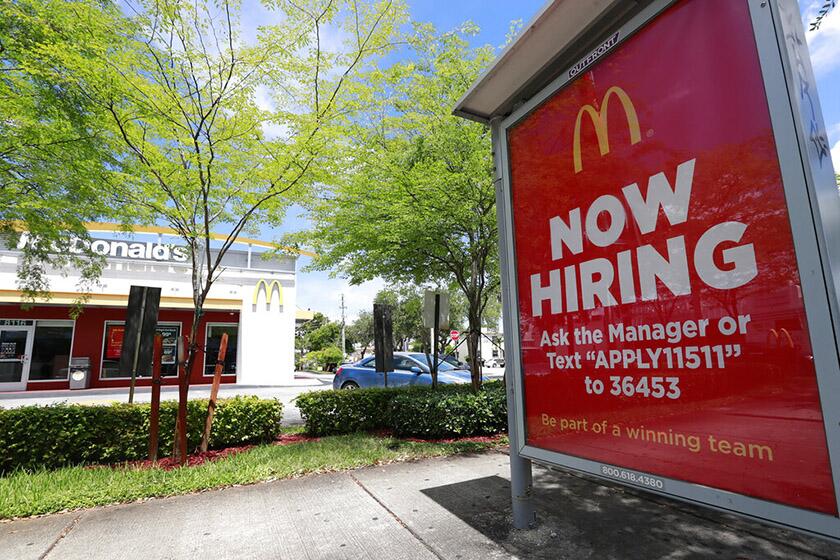State Economy Finally Recovering, Experts Say : Growth: Modest upswing is broad-based and includes substantial jobs creation. Even hard-hit L.A. is included.
As if a bad dream has finally faded, California’s battered economy has started to create substantial numbers of new jobs, most experts now agree, a performance that buttresses an array of other signs that a moderate economic recovery is reaching all the way into hard-hit Los Angeles County.
Job gains for 1994 are estimated in the range of 150,000 to 200,000 and include some high-paying professions. The figures make it clear that California has reached a watershed in its long journey out of recession: A jobs upturn is well under way and is expected to continue this year.
These signs of improving vitality encouraged Gov. Pete Wilson recently to propose tax cuts and led some optimists to predict that California’s growth pace will catch up with the nation’s in the coming months.
One hint of the changing climate: U-Haul last year tracked more households moving into California than out of it, a first since at least 1990.
“It’s a pleasure to report that recession has now given way to growth,” said Joseph A. Wahed, chief economist at Wells Fargo Bank in San Francisco, who predicts 400,000 new jobs for the state in the next two years.
Given the grim catalogue of floods, fires, earthquakes, riots and defense cuts, some might find good news about California’s much-maligned economy rather surprising. Orange County’s bankruptcy filing looms as another debacle with broader economic fallout.
The state’s 7.4% unemployment rate, although improving, remains higher than the nation’s. And the demoralizing battery of aerospace cutbacks has yet to play itself out.
“My first reaction was, ‘We better check these numbers,’ ” said David T. Kresge, a vice president with Dun & Bradstreet, on discovering that business failures actually declined within 20 miles of the Northridge earthquake epicenter last year. “I was incredulous.”
Nonetheless, the picture of a broad-based, modest recovery--one that even has tiptoed into Los Angeles--has become increasingly accepted among economists in the past few months. The robust national upturn is considered the key, reinforced by some of California’s own strengths, such as its allure for fast-growing enterprises in fast-growing industries.
Last week, three large California financial institutions--Bank of America, First Interstate and Wells Fargo--reported hefty earnings increases in late 1994, partly reflecting the stronger conditions.
Californians also can take heart in an improved jobs outlook.
The state Department of Finance estimates that California gained at least 150,000 jobs last year, mostly in a wide range of service fields. A majority do not pay much, such as many jobs in hotels and restaurants; others pay more moderately, such as construction.
But in a pronounced departure from the recent past, certain high-paying fields also appear to be expanding, according to payroll tax reports filed by employers. These include motion pictures, engineering, management consulting and some computer-related services--gains that helped offset the 1994 aerospace loss of 36,000 jobs, according to the Finance Department.
“Something like 60,000 to 65,000 of the jobs are in high-paying industries,” said Ted Gibson, chief economist at the Department of Finance. “No one would have thought it possible to have a recovery with aerospace hemorrhaging.”
Nowhere has the burden been heavier than in metropolitan Los Angeles, which still has its economic problems but now appears to be joining the rest of the state in recovery.
Retail sales rose 4% in Los Angeles County in 1994, after sliding for three years in a row. Nor was the action only inside stores: Permits to build factories and industrial warehouses increased for the first time since the late 1980s.
Preliminary statistics on payroll taxes have not been broken down by metropolitan regions, but some point out that growing fields, such as motion pictures and wholesale trade, are identified with Los Angeles.
The statewide indicators “fit nicely into an L.A. County story,” said Howard L. Roth, an economist at Bank of America.
Part of the story is a tale of healing. Real estate that used to be exorbitantly priced--or unavailable altogether--is now being eyed by purchasers such as Best Buy, a consumer electronics retailer that has targeted Southern California for a big push.
In 1994, the Minneapolis-based firm made its move, opening seven stores around Los Angeles.
“We created over 1,000 new jobs in Los Angeles in the fall,” said Ken Weller, senior vice president for sales, pointing out that the jobs typically pay from $8 to $15 an hour, with some managers making more than $60,000 a year.
The firm plans another thousand-plus jobs gain for this year, with nearly a dozen more Best Buy stores to be opened in 1995. “I definitely, definitely believe it’s on an upward trend,” Weller said, referring to the economy.
Oddly, such cheerful expectations clash with other government statistics on payroll jobs. These numbers, reported monthly by the state Economic Development Department and widely publicized, suggest a California jobs market that is nearly comatose: The 1994 non-farm gain was pegged at 0.2%, or 19,400.
But the findings appear to come from out-of-date information, critics say, and fail to detect the full role of new and expanding employers. EDD plans its annual overhaul of the numbers in February or March.
“The EDD numbers are so far off the mark that I’m paying little attention to them,” said David G. Hensley, an economist at Salomon Brothers in New York and former director of UCLA’s economic forecasting unit.
Meanwhile, EDD officials, who work in cooperation with the U.S. Labor Department, are in the awkward position of presenting a sicker view of the jobs picture than most economists accept.
“A case can be made that our (payroll) numbers may be understating the California job gain,” acknowledged Thomas P. Nagle, director of EDD. But he added: “There’s no one survey or tool that’s going to give you the full picture.”
The full assortment of evidence depicts the economy something like a patient after major surgery--healing steadily but far less formidable than before.
Consider industrial building permits in Los Angeles County. The good news is that they increased last year by more than 9%, according to data from the Construction Industry Research Board.
But the $60-million pace of such building remains just a tiny fraction--one-eighth or even less--than the level of pre-recession times. “We’re happy to see an increase,” said Ben Bartolotto, the board’s research director, noting that a double-digit gain is possible this year. Still, he said, compared to the past, it “isn’t a whole lot.”
Perhaps the strangest paradox in the story of California’s recovery is the role of last year’s Northridge earthquake.
Despite all the quake-related suffering, it appears that $15 billion in emergency money--$5 billion in federal aid and more than $10 billion in private insurance claims--temporarily boosted the Los Angeles economy in the middle of 1994. After the rebuilding, however, it could prove to be a slower time as quake victims hold down their spending.
“The stimulus probably accelerated L.A.’s entry into the statewide recovery by several months,” said Philip J. Romero, chief economist in the governor’s office. “But the earthquake will also make L.A.’s recovery slightly more modest than it would otherwise have been.”
At Power Lift SCMH, a dealer for Caterpillar forklifts in Pico Rivera, customers such as import-export firms, retailers and soft drink bottlers have been buying at a brisk pace. Some are involved in quake rebuilding, but many are not.
“We’re kind of a weather vane for the economy,” said Dan Crowley, general sales manager.
These days, the forecast is for good weather: The 300-employee firm may expand its work force by 15% this year, taking on mechanics who earn from $14 to $23 an hour and sales people whose commissions can push yearly earnings over $100,000.
“The first week in January (1995) was already one of our better months,” Crowley said.
Overall, Wahed of Wells Fargo said more than half of the expected 400,000 jobs gain in the next two years will be in low-paying services. But, he said, it will also include jobs in more lucrative areas, such as biotechnology and software.
UCLA forecasters now predict that the well-paying job categories of motion pictures, professional services and insurance will gain 109,000 jobs by 1997, helping offset the expected loss of another 96,000 jobs in aerospace.
“We’ve got a pretty robust start on the recovery now,” said Larry Kimbell, director of UCLA’s Business Forecasting Project. “California will surpass the U.S. in 1995.”
One reason the state may finally catch up to the U.S. growth rate, an out-of-reach goal since 1990, is that the nation is likely to slow down as higher interest rates take an increasing toll. Ultimately, the same forces will affect California, whose faster-growing economy should take longer to slow.
In the meantime, California is expected to keep recovering into 1996, if not beyond. “By 1996 we should be outperforming the nation by a clear margin,” said Lynn Reaser, chief economist at First Interstate Bank in Los Angeles.
There are intriguing signs that the message is filtering down to street level.
In addition to the trend seen by U-Haul, the latest driver’s license figures in Sacramento suggest that the outflow of Californians, which picked up during the recession, may have slowed late last year.
As votes of confidence in the Golden State, such gauges may be less than spectacular. But they are also an abrupt shift from the gloomy, recent past.
“People move into economically stable situations,” said Molly D. Bland, spokeswoman for U-Haul International in Phoenix. “I think it’s looking good for California.”
More to Read
Inside the business of entertainment
The Wide Shot brings you news, analysis and insights on everything from streaming wars to production — and what it all means for the future.
You may occasionally receive promotional content from the Los Angeles Times.










